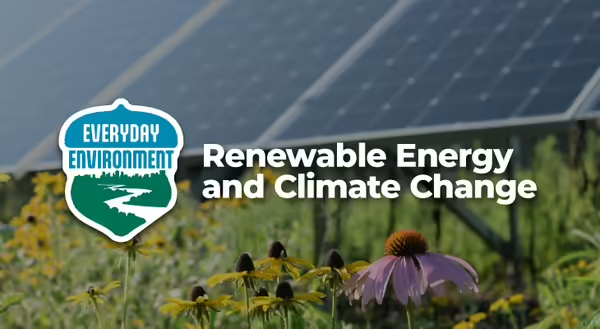
When I was growing up in St. Louis, crossing the Mississippi River in Alton was always my cue that we were almost home from a long road trip. Now that I live in Illinois, I know I am nearing home when I start to see windmills across the blue skies. Even at night, their blinking red lights signal the peaceful fields and the proximity of home. Moving to Illinois quickly reminded me of the increasing presence of renewable energy, as I am now greeted by windmills every morning. Renewable energy is all around us and plays an important role in reducing the rate of climate change.
In the U.S., about 88% of our energy comes from non-renewable sources, which are mostly petroleum, natural gas, and coal. Only 12% of our energy comes from renewable sources, including biomass, wind, hydropower, solar, and geothermal. Energy consumption is intertwined with almost every part of our lives. From waking up to a charged phone, driving a car to work, and cooking dinner for your family, there is no escaping how much energy we use. However, we can do our part to understand the impact and be mindful of how our energy plays a role in climate change.
How does energy connect to climate change?
Non-renewable energy sources such as coal, petroleum, and natural gas are all fossil fuels. They are located beneath the Earth's surface and emit significant amounts of carbon dioxide into the atmosphere when used as fuel. Carbon dioxide is a greenhouse gas that traps heat in our atmosphere, much like how a garden greenhouse retains heat. Greenhouse gases are necessary to keep us warm, but an excess of them can lead to continued heat-trapping and rising temperatures on Earth. Another dilemma with non-renewable energy sources is in their name: they are non-renewable. Once they are consumed, we cannot use them again.
That’s where renewable energy comes in
Renewable energy has a great amount of potential to reduce greenhouse gases, slow rising temperatures, and still support human energy needs. Utilizing available natural resources provides us with clean energy; These sources do not produce any harmful greenhouse gases, pollution, smoke, or clouds that would otherwise lead to reduced air quality. Two main renewable sources we have in Illinois are wind and solar. For windmills, the natural energy of moving air turns the turbine blades, and the generator converts the mechanical energy into electrical energy. Windmills should be established in a location with an average wind speed of at least 9 mph for a small turbine, and 13 mph for a utility-scale turbine. Solar energy is also becoming more common across Illinois. By utilizing photovoltaic cells, photons in light hit the solar panel and knock electrons free. The electrons moving around create electricity, and the electric current flows through the inverter, changing it from direct current (DC) to alternating current (AC), which we can use on the grid or directly connected to your home.
Energy consumption is embedded into our daily lives, but there are ways we can mitigate greenhouse gas emissions while still using energy. Being mindful of lights being left on in empty rooms or carpooling with a friend to an event are simple ways we can be conscious of our choices. Knowing where our energy comes from and how it impacts the environment is the first step toward conscious environmental action against greenhouse gases and climate change.
Resources and more information
U.S. Energy Facts Explained from the U.S. Energy Information Administration
Illinois state energy profile from the U.S. Energy Information Administration
Solar Energy Website from Illinois Extension
Thank you for reading!
Everyday Environment is a series of blogs, podcasts, webinars and videos on exploring the intricate web of connections that tie us to the natural world.
Subscribe to Everyday Environment Newsletter More about Everyday Environment